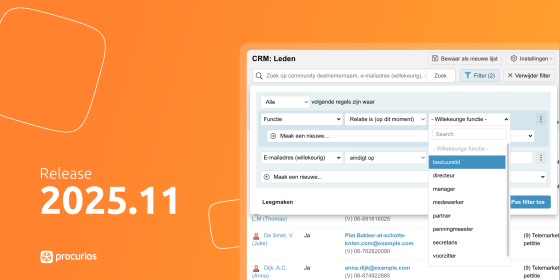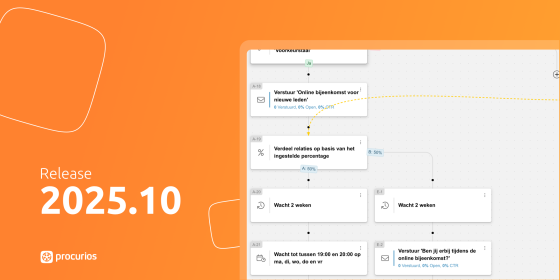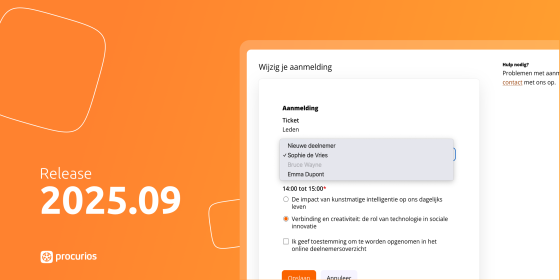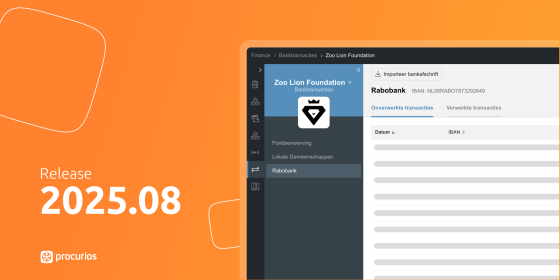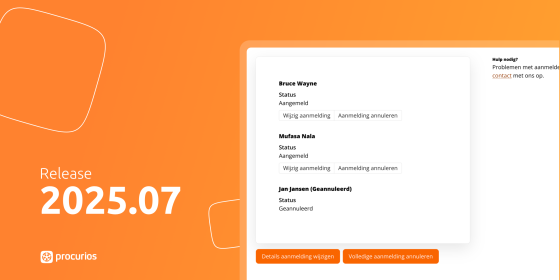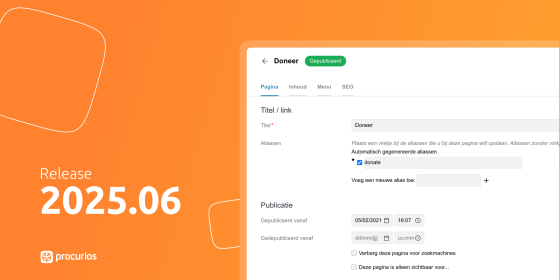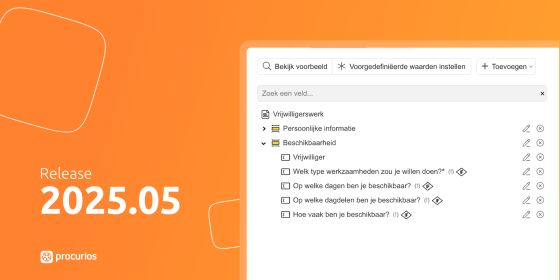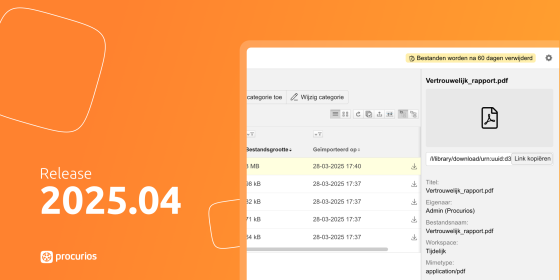Release 2024.08
As of July 23, 2024, all customers on the production version of the Procurios Platform will use release 2024.08. In this blog you can read what is new and what has been improved. For more information about the different versions of the platform, see the release page.

Communities: follow participants in the community
If your organization has set up a community, it will receive a nice addition that will enable your target group to see more relevant messages. From now on it is possible to follow other participants. Previously you could only follow a channel and you had less insight into what else a participant (of interest to you) posts.
If your community participants follow another participant:
- Do they see the messages from these followed participants on their home page, regardless of which channel they are posted in (including channels they do not follow, but are allowed to view)
- They will receive (if active) an email notification when this participant posts a new message or responds to another message

Donations: filter by tax-deductible donations
It is now possible to filter even more accurately thanks to a new filter option for (single) donations. You can now distinguish between tax-deductible and non-tax-deductible donations. You will find the filter option 'Tax deductible' both in the donation overview in Donations and in places where you filter relationships (such as in CRM and Marketing Automation). For example, you can contact all relations who meet the condition that they have made a tax-deductible donation.
Finance: payment link for invoicing and reminders improved
When setting up invoice emails and reminders, you can add a payment link. This link ensures that recipients of an invoice can pay their invoice with just a few clicks of a button. Before you can use this, some things need to be set up. To prevent your invoices from being unpaid due to design errors or adjustments to your website, we have adjusted this process. You will now receive notifications when a URL is no longer correct and there is a backup payment page so that a debtor can still pay the invoice.
What exactly is changing?
- Invoices or reminders will no longer be sent if an incorrect payment link is generated. For the SuperUser, a message will appear under 'Problems' (can be found via the gear at the top right of your platform).
- When setting up an email template, the platform checks the URL and provides immediate feedback if something goes wrong.
- In addition, if changes take place in the structure of your website and existing links no longer work, the debtor will be directed to a working (intermediate) page. As an administrator, you will then receive a notification about this.
This reduces the chance that debtors cannot pay their invoice because an invoice email produces incorrect URLs.
Finance: various payment methods added and changed
Do you use online donations or payments? Then you use a Payment Service Provider (PSP). They ensure the link between the bank and our platform. In this release there are some changes regarding the support of these payment providers.
New payment provider: Pay.nl
From now on there is also a link with the provider Pay.nl. We support the following payment methods for this PSP:
- iDEAL
- Bancontact
- Credit card
- PayPal
- Sofort
Expansion of Mollie and Buckaroo with commonly used payment methods in Belgium
Our links with Mollie and Buckaroo have been expanded to include a number of commonly used methods in Belgium. For Mollie these are: Belfius and KBC. For Buckaroo these are: Belfius, KBC and Payconiq.
Meetings & Events: canceling registration yourself is no longer possible if 'register group' is active
Do you ever organize meetings where it is also possible for groups to register? From now on, specifically for such a meeting, it is no longer possible to enable the option that a registration can be canceled or changed by a participant.
This prevents bothersome situations that arise when the registrant of a group wants to change or cancel a registration (for himself) and thus cancels the group registration.
Meetings & Events: field codes for 'additional information' available in email
You can set different emails during a meeting. To personalize this, you can use different field codes with information about the relationship, meeting, tickets, location and more. But what was still missing were the fields from the field Form for additional information. This is the form used to record additional information about participation during registration, such as dietary preferences. From now on, a field code is also available for every field you add in this form.

Meeting & Events: improvements to proof of participation
If you use participation certificates within meetings, a number of improvements have been made:
- If you use a list of attended meetings on the relationship card, you can now also download the issued certificate of participation from that list.
- Participation certificates can also be withdrawn after publication. The evidence is then deleted and can no longer be downloaded by a participant. It is possible to generate a new one.
- Within the participation certificate template it is now clear which tokens are linked to which meeting or relationship properties.
- The issuing of certificates is now limited to participants who have been 'registered' and 'present'. All other statuses of a participant will be ignored when issuing participation certificates.

Memberships: explicit end date on a subscription
Until now, the end of a subscription was determined by a combination of two fields: the expiration date and the termination date. This works well for most subscriptions, but is often difficult for users to understand. It was also difficult to retroactively cancel a subscription after the expiration date. This has now been resolved with the introduction of a new field: End Date.
The End Date field now explicitly indicates from which date the subscription is no longer active. From this release onwards, the status of a subscription (active versus inactive) is based on this end date and no longer on the combination of the Expiration and Termination Date. On the day of the End Date, the subscription is no longer considered an active subscription.
The Expiration Date remains, but now only indicates when a subscription will be renewed. The Termination Date is (and remains) the date on which the cancellation was communicated.
Are you a SuperUser? Please note:
The 'end of a subscription' function that the Expiration Date field previously had will no longer be available. Selections and Relation Lists that are still based on this continue to give the same result. We do recommend using the new filters for these selections and relationship lists End Date or the Status of the subscription. As of this release, the status is based on the End date and therefore no longer on the combination Expiration and Termination date. Need help with this conversion? Ask your consultant about this or arrange a consultant via portal.procurios.com

Memberships: temporary subscription for subscriptions with a rolling subscription period
Many associations have subscription variants that are temporary in nature. Consider, for example, a gift subscription or trial membership. This could only be set up by terminating the subscription after the first period. Suppose you use subscription periods of one month, the subscription will automatically end after the 1st month. But automatic termination, for example after 3 months, was not yet possible.
With the introduction of the End Date field (see release note above), it is now possible for subscriptions with a rolling subscription period to set a maximum subscription duration. When entering a new subscription, the end date is immediately entered.

Memberships: extend subscription via payment invitation
Do you offer subscriptions that are extended after payment has been made via a payment invitation? Then something will change for you in this release thanks to a number of nice adjustments.
Settings moved
In the previous release, Memberships received a major update where the settings for subscriptions are now done at the level of an 'Administration' (read more here). The same now applies to payment invitations. For each administration, you set which payment invitations should be sent and what the reminder process should look like. Setting up this process has immediately become a lot clearer. For example, if you have multiple types of memberships, you can set an alternative payment invitation and linked reminders for each type. These are then displayed consecutively in a flow.

Create and send invitations
The process for creating and sending payment invitations has also become clearer. Under the various tabs for each administration you will find the subscriptions that are currently in the individual process steps. This is how you go through the steps of: Renewable subscriptions > Payment invitations > Open invitations. From 'Open Invitations' you can send reminders or cancel subscriptions.

Platform: local relationship management for departments, regions, etc.
If your organization is divided into local departments or regions, the Memberships & Organizations (L&O) module can be used to determine which rules relationships must meet in order to be shown in a View of local administrators. For example: all relations with a specific zip code. But what if a local administrator wants to add a relationship in his 'own mini-CRM'? That would not have been possible before.
You guessed it: from now on. Within the L&O setup, it can now be set that a local administrator can add 'own' relationships. Removing these self-added relationships is also possible: they are then only removed from the organ. The relationship remains available within the entire CRM, because other relevant data may now be linked to this relationship that cannot simply be deleted.
Relationships that belong to a body due to set rules cannot be deleted by a local administrator. (Unless other/higher rights have been set for the administrator).
In relationship filters you can also filter on relationships that have been added to specific bodies. This way, as a (national) functional manager, you keep an eye on what is happening within the CRM landscape.
NB: We recommend consulting a consultant when setting up this functionality.






